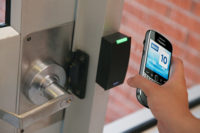HID Global, a global provider of secure identity solutions, released a mid-year update to its top 2016 security trends, based on customer insights into key market developments across enterprise, healthcare, banking and government markets. In the first six months of the year, the company noted continued forward movement in market adoption of mobile solutions and interest in the Internet of Things.
“Customers are increasingly investing in solutions that give them the flexibility to incorporate new and better capabilities that deliver a more satisfying connected experience for their users,” said Stefan Widing, HID Global president and CEO. “As we move through the middle of the year, we are experiencing a dramatic increase in customer demand for mobility, a better user experience, and connected environments. We have also forged new partnerships with major industry players who have the same vision to create an extraordinary user experience.”
Following are HID Global’s mid-year updates to the trends that the company forecasted in January:
Trend 1: “Mobilizing” security will make it more pervasive and personalized. A new, more secure identity lifestyle will be built around the convenience of ever-present mobile devices. Computer and network log-on, driver’s licenses and other applications will more seamlessly join physical security functions on phones, tablets and laptops. Wearables will be the next step, and phones will also work with RFID.
Mid-year update: Demand for mobile solutions continues to grow, along with an increasing focus on security issues. Multiple studies revealed fears about mobile security, countered by growing demand for the benefits of online and mobile functionality. The definition of mobility is also expanding to encompass the broader idea of “on-the-go” convenience and efficiency, where smartphones can be used as both a credential and a general-purpose reader for new use cases.
Trend 2: Security will move to a much greater focus on the user experience; this will help close the gap between planning and compliance, while ensuring that security adapts to rather than defines end user habits and lifestyles.
Mid-year update: Customers continue to want an easier, more trustworthy way to use digital identities to access on-the-go services and applications. Studies repeatedly highlighted the importance of the user experience — the Frost & Sullivan Asia Pacific study ranked it among the top two most important drivers for deploying mobile access control over the next three years. Biometrics continued to emerge as an effective solution for bringing together security and convenience together.
Trend 3: Secure, connected identities will fuel safety and innovation in how we work, shop and play: The industry will enter its next new chapter of connected identities, employing multi-layered security strategies that also include biometrics in order to bind these identities to their legitimate owners.
Mid-year update: An explosion of trusted digital identities began ushering in new innovation opportunities during the first half of the year. This trend is being fueled by a growing interest in wearables and use of sensors for IoT-based solutions aimed at new use cases for employee productivity, asset tracking, energy management and employee safety. These developments will pave the way for innovations like building occupant apps for the smart facility that enhance the user experience.
Trend 4: There will be more attention on privacy in an increasingly connected and mobile-first world: Identity will expand beyond people and their personal identity to the identity of objects and their authenticity, accentuating the need to protect personal information across increasingly interconnected devices, services and applications.
Mid-year update: Gartner forecasts that 5.5 million new “things” are getting connected every day in 2016, increasing the need for embedded security and privacy technology across the payments, transportation, industrial, consumer and healthcare markets.
Trend 5: Security policies and best practices will become as important as technology advances: The industry will sharpen its focus on not only what to deploy, but how — from the first U.S. mobile driver’s licenses to unified credential management systems that enable organizations to more holistically address both facility and information security. Rather than focus exclusively on preventing breaches, the industry will also adopt best practices for controlling what happens afterwards, so stolen identities are useless to thieves.
Mid-year update: Through mid-year, the world moved closer to deploying driver’s licenses on mobile phones, while two key policy issues emerged: protecting privacy by using a smartphone’s Bluetooth connection so users needn’t physically relinquish their smartphones to officers and officials, and ensuring citizens can control what data is made available to others. Beyond citizen ID, general security best practices and policies remain important for virtually any organization.









